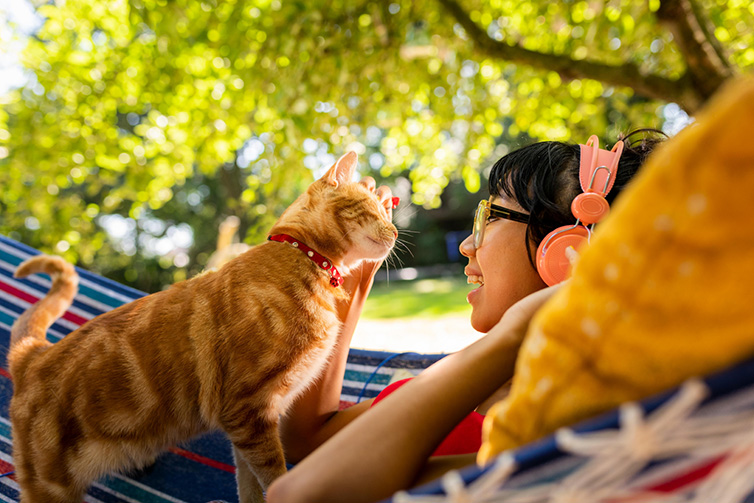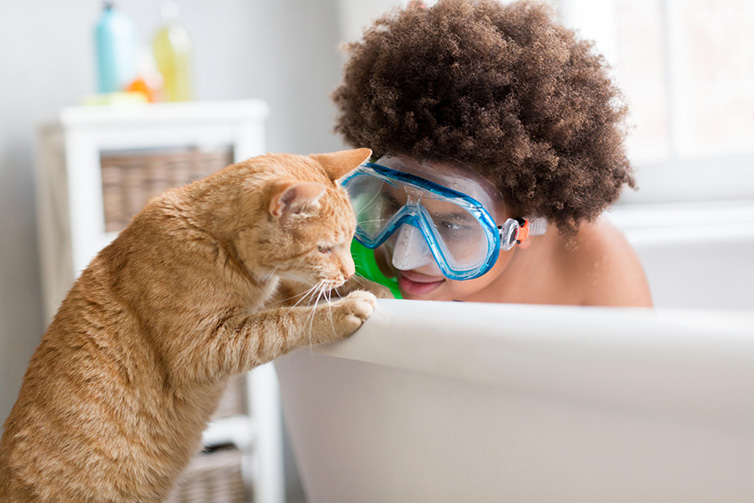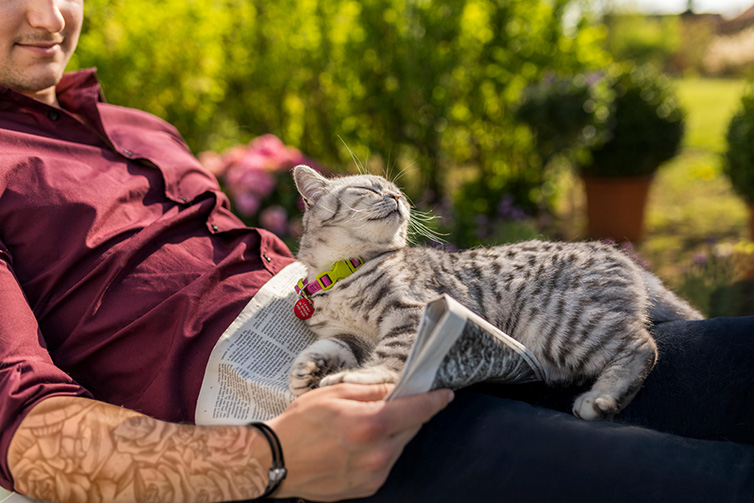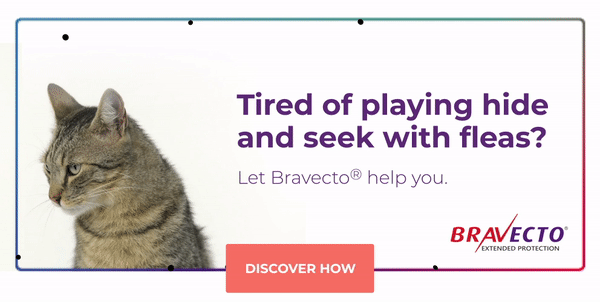Kitty communication!
What kitty human parent doesn’t talk to their furry feline? Most of us assume ‘baby talk’ voices when chatting to our kitties and we would be most embarrassed if a fellow human heard us: “Come my wittle nou-nou, Mommy’s got some dewicious foodies for you!” and “Who’s the bestest/loveliest/cutest/ handsomest boy in all the world, then?” Whilst sounding cute to you, these remarks would certainly embarrass any self-respecting feline if he/she could understand human talk.

Surely I should But … maybe they can? Perhaps it is possible that your cat understands you more than you think. Is it also possible that your cat may sometimes be trying to communicate with you? Fascinating questions. Let’s look a bit more closely look at the fascinating subject of cat communication.
What do we mean by communication?
Any form of communication refers to the exchange of information between living things. In the case of cats, we are referring to communication between themselves and between them and us. All animals and humans have a need to relate to and bond with each other, for both practical and emotional reasons.
What forms of communication do cats use?
Our furry friends use a variety of communication methods, including smell, visual, vocal and touch.
- Vocal

The sounds made by our kitties can be divided into three main types: mouth closed (murmuring, purring); mouth opened, then closed (meowing, howling); and mouth held open (snarling, hissing, growling, chattering). Aren’t you surprised at the number of different sounds?
In 1944, a lady (who obviously had nothing better to do with her time) called Mildred Moelk, published a phonetic study of cat sounds. Amongst other findings, she found that cats had six different kinds of meows, conveying anger, fear, pain, dissatisfaction, confidence and friendliness. She further classified vocalisations into five categories: the chirr, the call, the meow, the purr and the hiss/snarl/growl. (Wiki. Cat Communication)
Miaowing
Cats have a wide range of miaowing sounds which are used to communicate different types of messages. The miaow of an adult cat is almost always used to get their human’s attention. Kittens miaow to communicate with their moms, but a grown cat rarely miaows at another adult.
Why do cats miaow at their humans?
It could be to get attention, to greet you (and you should always greet back!), to ask for food, to ask to be let in or out or if they are developing a mental impairment – usually seen in elderly cats, possibly suffering from the feline form of Alzheimer’s. Try not to ignore miaowing – unless your kitty is a ‘drama queen’ – because it is usually their way of drawing your attention to something which may be wrong, such as an empty water bowl or the fact that you have shut him/her in a room.
Murmuring
These sounds, which include purring, are usually made with the mouth closed. They may be used to greet, for attention, to acknowledge and to show approval. Kittens may purr when they are nursing to show contentment and their mama may also purr, probably to tell her babies that “All’s well, my sweeties.” Purring may also be used by adult cats to greet and may be used when grooming each other. All members of the cat family can purr, but cats who can roar (lions, tigers, leopards and jaguars) can only purr when they breathe out. (Yes! You heard it here.)
Purring may also take place when kitty is stressed or ill. How do you know the difference? The key lies in the body language. If kitty is unhappy, the body will be tense with the ears back.
Aggressive Sounds
These are made with the mouth open and include yowls, growls, snarls, hisses and wails. They may be used in an offensive or a defensive situation.
- Visual

We all know that cats can perform such responses as arching their backs, erecting their hair, presenting sideways or blinking. These are forms of visual communication which are intended to tell other cats, or you, something. They can use their eyes, ears, mouths, tails and whole bodies to communicate. When a cat arches its back it makes it appear larger and is intended to be a threat; when cats are surprised, their ears become erect; erect hair is also a sign that your cat is trying to appear larger and threatening; erect hair can also indicate excitement; slowly blinking can signal relaxation. Changes to your feline’s facial features are often a good indication of their mood.
A cat’s posture can communicate emotions, depending on the situation. For example, a relaxed posture would be when your moggie is lying on its side or sitting, with its legs bent or extended and with the tail extended, loosely wrapped or held up. Another way your kitty shows that he/she is relaxed is when they lie on their back with their stomach exposed, suggesting vulnerability. Yawning can also indicate a feeling of relaxation. When your cat is alert, it may be sitting, lying on its stomach or standing and moving, with normal breathing, legs bent or extended and its tail curved back or straight. If your kitty is tense, it may be lying on its stomach with its back lower than its upper body – often called slinking – when standing or moving backwards. When standing, its hind legs may be bent and its front legs extended. The tail may be twitching. If a cat is afraid, its whole body may shake and be close to the ground. Breathing may be fast with the tail close to the body. A fearful cat may try to make itself appear smaller by getting close to the ground and arching its back. An aggressive cat is going to try to make an opponent afraid to avoid fighting, so it will stiffen its legs, raise its rump, hair erect, and ears back.
Ears
Cats’ ears may be erect when he/she is alert, more relaxed when calm and flattened against the head when aggressive or feeling threatened. Their ears can change position very quickly.
Eyes
When a cat stares directly at another cat it is usually seen as a threat or challenge. Conversely, lowered eyelids or blinking in front of their human parents usually indicates trust and affection. Slow blinking can suggest that your moggie is very comfortable with you.
Tail
Cats’ tails are often used to communicate. A vertical tail usually indicates that the cat is content, happy and confident; a swinging tail suggests relaxation; a low tail usually means that your kitty is unhappy for some reason. When stalking, the tail will usually be low and twitching with the body crouched: Beware! He/she may be on the warpath and getting ready to pounce. A U-shaped tail may suggest excitement or playfulness; a shaking tail held straight up might suggest happiness.
- Touch

‘Happy Paws’
We’ve all been charmed and, to be honest, sometimes irritated by a kneading kitty, especially when the extended claws get caught in your clothes or your flesh. What on earth is he/she doing this for? It is probably a throw-back to when kitty was a kitten and used to pummel poor momma’s teats to stimulate milk flow. It is generally an indication of happiness or contentment – small consolation if you are the human being scratched.
Scratching Furniture
It may drive you mad when kitty seems determined to shred your lounge suite, but he/she is not doing this to deliberately upset you. It is their instinct to scratch and you will certainly drive yourself mad if you try to stop it. All you can do is to discourage one spot mainly by encouraging another. This could be done by providing a scratching post of some kind, with a drop of cat nip to encourage its use.
Why do cats scratch?
Dr Jennifer Conrad, director of the Paw Project (petsradar.com) explains that it relieves their anxiety (have you ever tried it?) and is also a form of exercise by stretching muscles. They may scratch your lounge suite because that’s where you sit and your cat is letting other felines know this.
Grooming
Grooming is important to clean the fur and also to remove skin parasites, such as fleas.
You can assist your kitty in this regard by using Bravecto® Tick and Flea spot-on treatment, which lasts for three months.
Cats spend around 30-50 % of their resting time grooming. They may also lick other cats or humans, which is a sign of affection. (Cat spit may be good for your skin too!)
Head-Bumping
Some cats bump their humans with the front part of their heads – usually when human mom or dad is holding a scalding hot cup of coffee. There are scent glands in the front of their heads and this could be a way of getting attention. Together with check-rubbing, head-bumping another cat may also be a way of showing social dominance over the other cat.
- Smells
Cats also communicate through smells mainly in their urine, faeces and chemicals in their glands called pheromones. When you see kitty rubbing his/her face on objects, other cats or people, he/she is leaving small amounts of these ‘contentment’ pheromones. They have nine glands altogether in their bodies.
Spraying is a lovely way of marking territory, by leaving a urine sample on a surface, often in your home. It is usually practised by intact males who are in competition with other males. Female cats may also sometimes spray.
Household Tip!
What’s the most effective way of getting rid of kitty smells?
Clean the area with vinegar (check first to see that the vinegar doesn’t stain), then use an enzyme treatment to get rid of the smell.
And finally …
We hope that we’ve enlightened you a bit about your kitty’s often strange-seeming behaviour, when he/she is only trying to tell you something. It might not be much consolation if you have to re-upholster your couch, but be assured that your furry friend is not trying to punish you for failing to buy him/her that highly-expensive cat food; it is far more likely to be a way of saying “I wub you!”
ZA-BRV-220200009

Subscribe to our Newsletter
Get to know your furry friend better! Sign up for all things dog- or cat-related.
The Hairy Facts about the dreaded hairball
12 April 2021
Help! My dog’s barking mad! Volume 2
12 April 2021
Your Itchy, Scratchy Cat – All About Cat Skin Problems
12 April 2021
The Dog’s Diet: A Bone of contention?
01 April 2021
Mango Fly Worms: How to Spot and Eliminate them
Posted on November 28,2019
Managing Mange And Mites In Your Dog
Posted on June 11,2018
Why Do Cats Purr and How? Learn What Your Cat Is Saying
Posted on October 14,2020
How to Get Rid of Ear Mites in Dogs
Posted on November 06,2019









